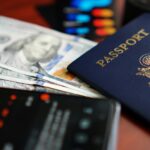Table of Contents
- A Monumental Shift: Canada’s Groundbreaking AI Screening at the Border
- Decoding the Technology: How Will CBSA’s AI Screening System Operate?
- The Strategic Imperative: Why Canada is Embracing AI for Border Security
- The Traveller’s New Reality: Key Impacts of AI Screening at Canadian Ports of Entry
- Critical Scrutiny: Unpacking the Ethical and Privacy Concerns of AI Border Control
- Proactive Preparation: Essential Steps for Navigating AI Screening in Canada
- Frequently Asked Questions About Canada’s AI Screening
A Monumental Shift: Canada’s Groundbreaking AI Screening at the Border
The landscape of international travel to Canada is on the cusp of a profound transformation. The Canada Border Services Agency (CBSA) has announced a groundbreaking initiative to implement advanced Artificial Intelligence (AI) screening systems at all major ports of entry—air, land, and sea. This ambitious project represents one of the most significant modernizations in Canadian border management history, fundamentally altering the process for everyone entering the country, from temporary visitors and international students to skilled workers and new permanent residents. The system is designed to leverage sophisticated algorithms and predictive analytics to conduct initial risk assessments of travellers before they even speak to a border officer. By analyzing a vast array of data points in real-time, the CBSA aims to create a more efficient, secure, and streamlined border experience. However, this technological leap forward also introduces a new set of complexities and considerations that all travellers must understand to ensure a smooth entry into Canada.
Decoding the Technology: How Will CBSA’s AI Screening System Operate?
While the full technical specifications remain proprietary, the core of the CBSA’s AI screening system is expected to function as a powerful data aggregation and analysis engine. It will likely integrate information from multiple sources to build a comprehensive risk profile for each traveller. This includes data submitted by the traveller through applications like an eTA or visa, information from the ArriveCAN app, and historical travel data. The system is anticipated to use advanced biometric matching, including facial recognition at Primary Inspection Kiosks, comparing a live image against the traveller’s passport and visa documentation. Furthermore, the AI may employ predictive analytics to identify patterns or anomalies that could indicate potential inadmissibility concerns. For instance, it might cross-reference travel itineraries, declared goods, and information provided to Immigration, Refugees and Citizenship Canada (IRCC) to flag inconsistencies that warrant further review. The outcome of this instantaneous analysis will categorize travellers into risk tiers, enabling border officers to expedite low-risk individuals while focusing their expertise on cases flagged for a more detailed, secondary inspection.
The Strategic Imperative: Why Canada is Embracing AI for Border Security
The adoption of AI screening is driven by a dual mandate: enhancing national security and improving the efficiency of border processing. With global travel volumes steadily increasing, the CBSA faces the immense challenge of managing millions of entries annually without compromising safety. AI offers a powerful solution to this dilemma. By automating the initial assessment of low-risk travellers, the system can significantly reduce wait times and alleviate congestion at busy airports and land crossings, creating a more positive first impression for tourists, business travellers, and newcomers. On the security front, the AI system is a formidable tool for identifying potential threats. It can analyze complex data sets to detect patterns associated with misrepresentation, customs violations, or other security concerns that might be imperceptible to a human officer during a brief interaction. This data-driven approach allows the CBSA to allocate its human resources more effectively, dedicating experienced officers to resolving complex cases identified by the technology, thereby strengthening the integrity of Canada’s borders in an increasingly complex world.
The Traveller’s New Reality: Key Impacts of AI Screening at Canadian Ports of Entry
The introduction of AI screening will have tangible effects on every individual crossing the Canadian border. While many travellers can expect a faster and more seamless experience, others may face heightened scrutiny. It is crucial for anyone planning to enter Canada to be aware of these potential changes and their implications. The system’s reliance on data consistency means that even minor discrepancies between different applications or declarations could be flagged, leading to delays and questioning. Understanding the new dynamics at play is essential for a successful and stress-free entry.
Here are some of the most significant impacts to anticipate:
-
Emphasis on Data Accuracy: The AI will cross-reference information from various sources, including past visa applications, flight manifests, and customs declarations. Any inconsistency, no matter how small, could trigger an alert for secondary inspection. Ensuring all information provided is completely accurate and consistent is more critical than ever.
Potential for ‘False Positives’: Algorithmic systems are not infallible. There is a risk that the AI could incorrectly flag a low-risk traveller based on unusual but legitimate travel patterns or other benign data anomalies. Travellers should be prepared for the possibility of being sent to secondary inspection even if they have done nothing wrong.
Reduced Officer Discretion at a Primary Level: The AI’s initial risk assessment may heavily influence the interaction at the primary inspection point. A ‘green light’ from the system could lead to a very brief interaction, while a ‘yellow’ or ‘red’ flag will almost certainly result in a referral for more in-depth examination.
Increased Importance of Digital Footprints: While not officially confirmed, future iterations of such systems could potentially analyze publicly available digital information as part of their risk assessment. Maintaining a consistent and professional online presence may become an indirect factor in the border crossing experience.
The Need for Clear Recourse: For those who are consistently flagged or face entry issues due to the AI’s assessment, understanding the process for recourse and review will be vital. The government will need to establish transparent mechanisms for travellers to challenge or seek clarification on decisions influenced by the AI.
Critical Scrutiny: Unpacking the Ethical and Privacy Concerns of AI Border Control
As with any large-scale implementation of AI, the CBSA’s new system raises significant questions regarding ethics, privacy, and transparency. Civil liberties advocates and immigration professionals have voiced valid concerns about the potential for algorithmic bias. If the AI is trained on historical data that contains implicit biases, it could disproportionately flag individuals from certain countries, ethnicities, or backgrounds, leading to systemic discrimination. The ‘black box’ nature of some advanced AI models also presents a challenge to transparency; if the CBSA cannot fully explain why the AI made a particular decision, it undermines a traveller’s right to a fair and accountable process. Furthermore, the immense amount of personal data being collected, stored, and analyzed creates a substantial privacy risk. Strong safeguards, independent oversight, and clear policies on data retention and usage are paramount to maintaining public trust and protecting the fundamental rights of everyone seeking to enter Canada.
Proactive Preparation: Essential Steps for Navigating AI Screening in Canada
In this new era of AI-powered border control, preparation is paramount. Travellers can take several proactive steps to minimize the risk of complications and ensure their entry into Canada is as smooth as possible. The most important principle is consistency. Before travelling, review all past immigration applications submitted to IRCC and ensure that the information aligns with your current travel plans and declarations. Double-check your ArriveCAN submission for accuracy. It is also wise to carry documentation that supports the purpose of your visit, such as a letter of invitation, proof of employment, or school acceptance letter, even if you are not explicitly required to. Be prepared to answer questions clearly and honestly, and remain calm and cooperative if you are referred for secondary screening. Understanding that the system is designed to identify inconsistencies will help you focus on providing clear, accurate, and verifiable information at every step of your journey to Canada.
Frequently Asked Questions About Canada’s AI Screening
What is the new AI screening at the Canadian border?
It is an advanced technological system being implemented by the Canada Border Services Agency (CBSA) that uses artificial intelligence to conduct a real-time risk assessment of travellers. The system analyzes data from various sources to help streamline the entry process for low-risk individuals and flag those who may require further examination.
How does the CBSA’s AI screening system work?
The system integrates and analyzes data from a traveller’s immigration applications, travel history, and real-time biometric information from airport kiosks. It uses algorithms and predictive analytics to look for inconsistencies or patterns that may indicate a risk, helping border officers make more informed decisions.
What happens if the AI flags a traveller for review?
If the AI system flags a traveller, they will be referred for secondary inspection. This involves a more in-depth interview with a human CBSA officer, who will ask further questions and may review documentation to resolve the issue flagged by the system and make a final determination on admissibility.
How can travellers prepare for the AI screening in Canada?
The best preparation is to ensure absolute consistency and accuracy across all your documents and declarations. Before you travel, review past visa applications and make sure your current information aligns. Always be honest and carry supporting documents for the purpose of your trip.
Does the new AI system replace human CBSA officers?
No, the AI system is a tool designed to support, not replace, human officers. It automates the initial screening process to enhance efficiency, but the final decision on a person’s admissibility to Canada will always be made by a trained CBSA officer, especially in complex or flagged cases.
Talk to us to find out more. ->
The content above is not intended to provide legal advice or opinions of any kind and may not be used for professional or commercial purposes.







